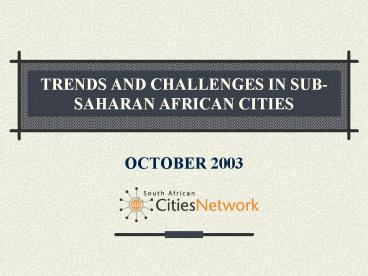TRENDS AND CHALLENGES IN SUBSAHARAN AFRICAN CITIES - PowerPoint PPT Presentation
1 / 21
Title:
TRENDS AND CHALLENGES IN SUBSAHARAN AFRICAN CITIES
Description:
Formality and informality. Skilling for change. AFRICAN CITIES AND EMPLOYMENT ... The establishment and growth of informal settlements. Financial exclusion ... – PowerPoint PPT presentation
Number of Views:71
Avg rating:3.0/5.0
Title: TRENDS AND CHALLENGES IN SUBSAHARAN AFRICAN CITIES
1
TRENDS AND CHALLENGES IN SUB-SAHARAN AFRICAN
CITIES
- OCTOBER 2003
2
MILLENNIUM DEVELOPMENT GOALS
- Target 11
- By 2020, to have achieved a significant
improvement in the lives of at least 100 million
slum dwellers - Progress will be monitored through...
- Indicators 30 and 31
- (30) Proportion of people with access to improved
sanitation - (31) Proportion of people with access to secure
tenure - United Nations General Assembly (A/56/326)
- 6 September, 2001
3
AN URBANIZING WORLD
- Over the next 2 decades, more than 88 of
population growth in developing countries will be
urban - By 2025, 78 of the worlds urban population will
be in developing countries - Increased urbanization is increasing the
importance of cities and is driving
decentralization.
4
CITIES ARE GROWING
- By 2015, there will be 23 mega cities with
populations in excess of 10 million. Of these,
19 will be in developing countries. - By 2020, Africa will have 11 cities having more
than 5 million inhabitants and more than 3000
cities with populations in excess of 20 000 (an
increase of almost 300 from 1990)
Cities Over 1 Million
5
HOW BIG IS AFRICAN URBANISATION IN GLOBAL TERMS?
6
AFRICAN URBANISATION
- Africas urban population only constitutes 7 of
the world urban population. - Today, urban areas account for 34 of the total
population - Sub-Saharan Africas urban population will
approach 440 million, or 46 of its projected
total of 952 million by 2020. - The average rate of urbanization in Africa is the
highest in the world at 3.97 p.a.
7
PATTERNS OF URBANISATION
- Urban population growth rates are not distributed
evenly - Highest growth rates found in Eastern Africa and
West Africa - Lowest growth rates are found in Southern Africa
- Structure of urbanization differs
- West Africa - few secondary cities, populations
tend to concentrate in one or a few large cities
- East Africa - population growth more evenly
distributed between secondary and tertiary cities
- African megacities
- By 2015 Lagos will have a population in excess of
10 million inhabitants - 70 African cities will have populations of more
than 1 million people.
8
City Strategic Framework Building blocks for
integrated development
Inclusive City
Productive City
City Strategy (CDS)
Well- governed City
Sustainable City
9
Productive African Cities
10
AFRICAN URBAN ECONOMIES
- Structural change in African economies
- Urban economic activities in Africa constitute a
growing share in GDP. - Urban areas already accounts for 60 of the
regions GDP. - City product in African cities is generally
higher than the national product. - Key Challenges
- African cities and the global economy?
- Optimizing city productivity
- Understanding urban-rural linkages
11
AFRICAN CITIES AND EMPLOYMENT
- Unemployment in African cities is the highest in
the world, averaging around 24. - Up to 54 of all employment is in the informal
sector. - Challenges
- Formality and informality
- Skilling for change
12
Inclusive African Cities
13
THE URBANISATION OF POVERTY
- National and local authorities are not prepared
for the unprecedented growth of cities and this
creates an upsurge in urban poverty - The cities of Africa have the highest rates of
urban poverty in all regions, over 40 and
rising. - This poverty manifests itself in a number of ways
including - The establishment and growth of informal
settlements - Financial exclusion
14
INFORMAL SETTLEMENTS IN AFRICA
- Connection levels for all services in Africa are
lower than in all other world regions - Approximately 40 of residential accommodation in
Africa is non-permanent, over 148 million people
live in urban slums - House price-to-income ratios
- The highest in the world at 12.5
- Double that of cities in highly industrialized
countries - Challenges
- Supply meets demand?
- Funding the backlog
- Land management and allocation systems
- Building Partnerships
15
CITIES AND FINANCIAL EXCLUSION
- Access to credit is severely constrained.
- The mortgage-to-credit ratio
- measures the size of the formal housing finance
sector and its ability to provide households with
funds - Africa has a ratio of 8.4.
- Challenges
- Housing finance institutions are poorly developed
- Housing institutions face legal or institutional
constraints which impede lending, particularly
tenure.
16
Sustainable African Cities
17
AFRICAN CITIES AND HEALTH
- Poor infrastructure within urban areas gives rise
to health problems within cities - Cities become a source of disease and child
mortality rises rather than falls
18
AFRICAN CITIES AND THE ENVIRONMENT
- Brown issues
- Waste disposal systems
- Sanitation
- Green issues
- Urban greening
- Urban agriculture
- Challenges
- Reducing the urban footprint sprawl and impact
- Balancing competing agendas
19
Well Governed African Cities
20
GOVERNANCE
- Demographic change and the importance of cities
- Decentralization
- Political decentralization (Power, authority,
demarcation) - Financial decentralization (un-funded mandates)
- Administrative decentralization (effectiveness,
efficiency, responsiveness) - Challenges
- Transparency and accountability
- Addressing corruption
- Enforcing compliance
- Citizenry and community participation
21
CONCLUSIONS
- Irrevocable shifts taking place
- Urbanization of Africa will create political and
social challenges - Present a critical opportunity for change
- Working together
- African solutions for Africans NEPAD focus
- Sharing lessons between cities
- Donor responsiveness to urban challenges
- The African voice on urban issues































